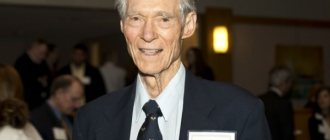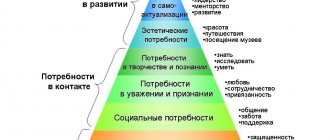All the most famous theories of emotions in psychology consider emotional states together with the physiological processes that occur in the body. They not only accompany them, but also explain why these emotions arise. Researchers associate physiological changes in the body with emotional expressions and prove that different emotions are characterized by a certain set of signs. In order to classify or determine the parameters of emotional states, you will need to turn to the corresponding physiological processes.
With the help of emotions, a person can directly influence his interlocutors and others. They are accompanied by facial expressions, pantomimes and gestures that reflect his internal state and are quite understandable to other people.
Articles on the topic
- What is professional stress, its main signs and types 08/29/2021
- Self-analysis and self-assessment of a teacher’s professional activity as the main criteria for his work 08/13/2021
- What is the role of self-esteem in choosing a profession 08/13/2021
- What does success in business depend on and how not to lose it 07/12/2021
What are emotions and what do they look like?
Photo by Charles Deluvio on Unsplash
Translated from Latin - the emotion “shocks, excites.” Emotions can be compared to a palette of colors. Without emotions, life will be dull. It's like living in twilight. Some people say: “I don’t want to feel emotions anymore! I want to be emotionless." Thus, the mistaken belief is that if they stop experiencing emotions, their life will become better, easier.
In fact, there are people who do not experience emotions. Emotional disturbances may be associated with autism, psychopathy, or alexithymia, a term that refers to difficulty verbalizing one's condition.
Emotions! They can also be compared to seasoning. Without them, life will become bland. And as proof, we can give the following example: the emotional-sensory sphere contains bodily sensations. When we see a loved one, we feel butterflies in our stomach, or when we feel angry, we may feel a stomach cramp.
Our brain assigns a certain value to each sensation. This is how you and I understand whether it is positive or negative, weak or pronounced.
Theories of emotions by Anokhin, Simonov and Festinger.
There is no need to run away or close yourself off from emotions. It is important to understand them. In terms of emotions, there is no axiom. But there are authoritative theories. This article will talk about them. They will open the curtain for you into the world of emotions.
List of used literature
- Afanasyev A.Yu. Syntax of love / A.Yu. Afanasiev. – M.: Izvestia, 2013.
- Vilyunas V.K. Psychological mechanisms of human motivation./ V.K. Viliunas. - M.: Moscow State University Publishing House, 1986.
- Vilyunas V.K. Basic problems of the psychological theory of emotions / V.K. Viliunas. – M.: Psychology of emotions. Texts, 1984.
- Wundt V. Essays on psychology. - M., 1912.
- Vygotsky L. S. Spinoza and his teaching about emotions in the light of modern psychoneurology // Questions of Philosophy. - 1970. - No. 6.
- Darwin Ch. On the expression of emotions in humans and animals / Ch. Darwin. – St. Petersburg: Peter, 2001
- James W. Psychology / W. James - M.: Nauka, 1991
- Ilyin E.P. Emotions and feelings / E.P. Ilyin. - St. Petersburg: 2001.
- Rubinstein S. L Being and consciousness. About the place of the psyche in the universal interconnection of phenomena of the material world. - M., 1957.
- Rubinstein S. L Fundamentals of general psychology. - M., 1946 (reprint - St. Petersburg: Peter, 1999).
- Ekman P. Psychology of emotions. I know how you feel /P. Ekman - St. Petersburg: Peter, 2012.
- Lectures (video) on the course “General Psychology” by Moscow State University professor V.V. Petukhova.
Theory of emotions P.V. Simonova
Quite an interesting, but at the same time very simple theory from the domestic psychophysiologist, biophysicist and psychologist P. V. Simonov. It's called Information Theory of Emotions. According to Simonov, information theory presupposes clarifications in part of the biological theory of P.K. Anokhina.
The difference between information and biological theories is that it is important not only to have information about the result in the context of achievability/unattainability, but also to know the degree of probability.
The fundamental formula of Simonov's theory
Her idea is as follows:
E = P * (Is-In), where:
- E - emotion.
- P - current need (its strength and quality).
- IS - information about the means that an individual has at the moment.
- In - information about the means that are necessary to satisfy the need.
- Is-In is the probability of satisfying a need, taking into account acquired or genetic experience.
Conclusions according to the formula:
- There will be no emotion if there is a need, but at the same time the person has all the necessary information to satisfy it.
Let's say the need to eat something sweet prompted you to go to the kitchen. You know that a delicious cake is waiting for you there. It is clear that in this case there will be no emotions. You will simply satisfy your need.
- Emotion will arise when there is a need
Giphy
But if, when you go into the kitchen, you see that someone in the family has eaten your cake, or, on the contrary, bought another one, an emotion will appear.
The role of emotions in Simonov's theory
Simonov said that, no matter how paradoxical it may sound, but thanks to emotions, the assessment of the measure of ignorance is ensured. This formula allows you to understand that negative emotions arise due to insufficient information. Positive when there is an abundance of information.
As an example: a negative aftertaste from a vacation due to the fact that expectations did not coincide with reality. That is, expectations were too high, but in reality many “pitfalls” surfaced that were not initially taken into account.
The conclusion is:
- negative emotions are the result of an insufficient amount of information, or unpleasant information (for example, a person is afraid to fly. Cases of plane crashes will be unpleasant information for him);
- positive emotions will arise when there was enough information, or when it turned out to be higher than expected (for example, a vacation trip. In this case, unexpected bonuses in the form of an improved hotel room or additional services provided free of charge by the hotel).
The essence of Simonov's theory is that in normal situations, when a person's behavior is focused on those events that have already occurred, taking into account a clearly defined goal and action plan, he can achieve what he wants without the help of emotions.
But then, when there are many gaps in the situation or a person is faced with something for the first time, another tactic arises regarding satisfying the need. Emotions will be like clues. For example, the emotion of fear arises in the absence of information necessary for protection. Emotions help in searching for new information.
Analysis of emotions using Simonov's formula
P - what do I want?
Ying - how can I achieve this?
Is - what can I do for this?
Photo by Vanessa Bucceri on Unsplash
The main thing to consider is that you need to not only know, but also try to increase your capabilities (Is). Cut off all that unnecessary information about acceptable obstacles that may arise on the way to satisfying the need (In).
Cognitive dissonance theory
L. Festinger proposed this theory based on studying a person’s perception of his expectations and reality, as well as how they relate to each other. He argued that if a person’s expectations are fully realized, the individual remains satisfied and then positive emotions arise. If reality does not meet his expectations, an uncomfortable state and negative emotions arise. In this case, a person begins to look for another way out, and there are two possible options. Either a person changes the cognitive aspect of the current situation, that is, he changes his expectations and attitude towards reality so that the negative emotion is leveled, or he looks for a way to change the undesirable result that he observes in reality and does not agree with.
Theory of emotions by P.K. Anokhin
Soviet physiologist P.K. Anokhin, in developing his theory, focused on Charles Darwin's theory of evolution. This theory is called the “Biological Theory of Emotions.” According to Anokhin, it turns out that emotional sensations, in the process of evolution, were established as a kind of tool that keeps the process within acceptable boundaries.
Thus, emotions prevent the nature of destruction associated with lack and excess information about certain factors of the life of the body.
In the theory under consideration, emotions are assigned roles aimed at achieving goals:
- Mobilization
- Stimulus
There are two stages:
- Formation of needs
- Satisfying needs
Photo by Kindel Media: Pexels
According to Anokhin's biological theory, needs generate negative emotions as a tool of mobilization, thus helping to satisfy the need in the most optimal way. Positive emotions arise when the desired result is achieved.
An unmet need will result in a feeling of discomfort.
The essence of Anokhin's biological theory
Negative emotions indicate deviations in the internal environment and trigger a specific program of action. After the desired result is achieved, a positive emotion arises. It acts as the final fixing factor. But it should be noted that a positive emotion will arise only when the information from the results of the action taken coincides with the expected result.
A positive emotion, fixed in memory, will subsequently take part in the process of motivation and have an impact on decision-making about how to satisfy a need.
Programmed negative emotions that arise when the result does not coincide with the expected lead to inhibition of ineffective actions and the search for new optimally successful ones aimed at achieving the goal.
Photo by Pavel Danilyuk: Pexels
Cannon-Bard theory
American psychologists developed a thalamic theory of emotions, which was opposed to the peripheral theory. They believed that a certain emotion cannot be a consequence of the body's physical reaction to a stimulus for several reasons. The same bodily reaction can indicate different emotions, and with the same emotional state, completely different physiological manifestations can occur. Scientists have concluded that the emotional reaction appears approximately simultaneously with the physiological one. And the bodily reaction is due to the active work of the thalamus, which is located in the brain, and upon receiving a signal about an external stimulus, it triggers processes aimed at producing both a physiological and emotional reaction. Thus, the above reactions of the body proceed in parallel.
James-Lange theory of emotion
This theory, independently of each other, was developed by W. James and K. Lange in 1880-1890. The fundamental essence of the theory is that emotions are a consequence of an individual’s awareness of reflex physiological changes in the body. It's called the Peripheral Theory of Emotions.
The key point is that emotions manifest themselves as a response when the brain reacts to information received by the body's nervous system. Simply put, the essence of the theory is that emotional experiences are a “product” of physiological changes.
Based on this theory, it turns out that a person experiences fear because he is trembling, and does not tremble because he became afraid; he is sad because his eyes are filled with tears, and does not cry because he feels sad.
The peripheral theory inherits the views of Charles Darwin, according to which animals do not have consciousness, but express their state through bodily expression.
Strengths and weaknesses of the theory
- Strong
The following experiment was conducted: the subjects had to evaluate the cartoons shown to them and the jokes voiced. At the same time, they had to hold the pencil in their mouth. At the same time, one group was required to hold it with their teeth while involuntarily demonstrating some semblance of a smile, while others were required to hold it with their lips, resulting in a frowning and tense facial expression.
It's easy to guess that the first group found caricatures and jokes funnier.
- Weak
The range of human bodily reactions is lower than the range of emotional experiences.
For example, tears represent grief and sadness. But we can also cry for joy.
The expression of emotions is determined by cultural norms. For example, in China it is customary to inform your superiors and elders about your grief with a smile. Thus, downplaying the extent of your grief and not disturbing your superior.
Facial feedback theory
The appearance of this theory is associated with the scientific work of William James, but in 1962 it was developed by Sylvain Tomkins. According to this theory, emotional experience is at least enhanced by feedback generated by the activation of facial muscles that are involved in facial emotional expression; otherwise we simply evaluate the event rationally. In other words, a smiling person is happy, a frowning person is worried or sad. It is the movements of the facial muscles that give the brain a hint based on which it identifies the source of the emotion, and not vice versa.
Let's return to our example. When a woman hears someone's footsteps behind her, her eyes widen and her teeth clench. The brain interprets these changes in the facial muscles as an expression of fear and tells the woman that she is now afraid.
Carney Landis Research
In 1924, a graduate student psychologist at the University of Minnesota, Carney Landis, designed an experiment to better understand the relationship between facial expressions and human emotions. Landis wanted to know whether people experiencing the same emotions exhibit universal facial expressions. For example, will different people have the same facial expression when they experience disgust?
To participate in the experiment, Landis recruited mostly graduate students like himself. He drew black lines on the subjects' faces to make it easier to follow the smallest movements of their facial muscles, and then they were exposed to various stimuli, which, according to Landis, should have caused a strong emotional reaction. The researcher photographed each reaction. The subjects sniffed ammonia, watched a pornographic film, and stuck their hand into a bucket of frogs. But the most amazing part was the final part of the experiment. The participant was given a live rat and asked to decapitate it. This idea caused everyone sincere disgust, however, two thirds of the subjects complied with the requirement. And for those who refused to cut off the rat's head, Landis completed the task himself.
Although this experiment did not reveal absolute universality in human facial expressions and did not find a direct connection between facial expressions and the experienced emotion (disgust), it in many ways anticipated the results of another study - Stanley Milgram's well-known experiment with submission to authority, conducted forty years later. Landis was overly focused on studying the facial expressions of the subjects and did not understand that the most interesting result of the experiment was that the majority of the participants meekly carried out even the most senseless and cruel orders of the experimenter in power.
Paul Kleinman: Psychology. People, concepts, experiments
K. Izard's theory of emotions
It's called the Theory of Differential Emotions. Developed by American psychologist and specialist in the field of emotional psychology Carroll Izard. This theory got its name by focusing on those emotions that are considered as different experiential and motivational processes.
Photo by Kelvin Yan on Unsplash
This theory gives emotions the functions of determinants of behavior with a wide range: from violence and manslaughter to self-sacrifice.
According to Izard, the emergence of emotions occurred as a result of biological evolution, differing on three central grounds:
- biological factors in the performance of mental activity;
- pantomime and facial expressions;
- the specificity of the experiences that a person experiences.
Based on the above, Izard identified ten basic emotions, which are the foundation of the human motivational system. They include:
- Joy
- Sadness
- Astonishment
- Interest
- Guilt
- Contempt
- Disgust
- Anger
- Fear
- Shame
Communication and all kinds of processes of combinations of these basic emotions generate all other emotions.
Adaptation syndrome theory
The concept of adaptation syndrome was introduced by H. Selye, considering it as stress, due to which the body adapts to difficult environmental conditions.
He conducted research on animals, studying the influence of various factors on their behavior and came to the conclusion that the adaptation process includes three stages:
Alarm stage
At this stage, a person usually feels anxious and restless. And sometimes a feeling of elation, in those cases where he feels particularly confident and ready to cope with the upcoming task.
Resistance stage
The level of cortisol in the blood increases, blood pressure rises, and the heart rate increases. The body is mobilized, it is in good shape and in this state it is capable of accomplishments.
Exhaustion stage
When interaction with a stressful stimulus is prolonged and it becomes difficult for a person to resist it, internal strength and energy dries up. The work of all internal systems slows down. General health worsens. And if the body becomes too weak, a person can become very seriously ill.
Tax is defined as a percentage of the tax base corresponding to the tax rate.Based on the results of the reporting (tax) period, taxpayers calculate the amount of the advance payment based on the tax rate and profit calculated on an accrual basis.
During the reporting period, taxpayers calculate the amount of the monthly advance payment:
- in the 1st quarter of the year = advance payment due in the last quarter of the previous year.
- in the 2nd quarter of the year = 1/3 * advance payment for the first quarter
- in the 3rd quarter of the year = 1/3 * (advance payment for the first half of the year - advance payment for the first quarter).
- in the 4th quarter of the year = 1/3 * (advance payment for nine months - advance payment for half a year)
Taxpayers have the right to switch to calculating monthly advance payments based on actual profit received by notifying the tax authority no later than December 31 of the year preceding the year of transition.
In this case, advance payments are calculated based on the tax rate and the actual profit received, calculated on an accrual basis from the beginning of the tax period to the end of the corresponding month.
Only quarterly advance payments based on the results of the reporting period are paid by:
- organizations whose sales income over the previous 4 quarters did not exceed an average of 3,000,000 rubles for each quarter,
- budgetary institutions,
- foreign organizations operating in the Russian Federation through a permanent representative office,
- non-profit organizations that do not have income from sales,
- members of simple partnerships,
- investors in production sharing agreements,
- beneficiaries under trust management agreements.
The tax at the end of the year is paid no later than March 28 of the following year.
Advance payments based on the results of the reporting period are paid no later than 28 days from the end of the reporting period.
Monthly advance payments are paid no later than the 28th day of each month.
Taxpayers who calculate monthly advance payments based on actually received profits pay them no later than the 28th day of the month following the month for which the tax is calculated.
The amounts of paid monthly advance payments are counted when paying advance payments at the end of the reporting period. Advance payments based on the results of the reporting period are counted against the payment of tax based on the results of the tax period.
Features of tax calculation and payment:
- organizations with separate divisions
- residents of the Special Economic Zone in the Kaliningrad region











